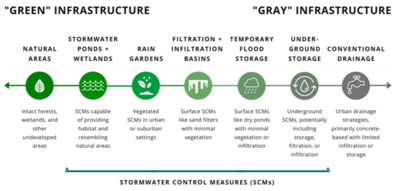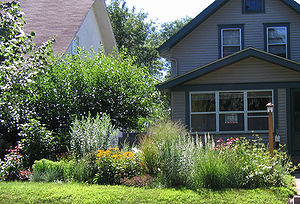
Difference between revisions of "Green Stormwater Infrastructure (GSI) and sustainable stormwater management"
m |
|||
| Line 1: | Line 1: | ||
| + | = = | ||
| + | [[file:Check it out.png|200px|thumb|alt=check it out image|<font size=3>[https://cities-today.com/31-cities-commit-to-green-infrastructure-targets/ 31 cities commit to green infrastructure targets] (Cities Today, July 13, 2021)</font size>]] | ||
| + | |||
[[File:Native landscaping.jpg|thumb|300px|alt=photo of a rain garden planted with native vegetation|<font size=3>Example of a rain garden planted with native vegetation. In addition to providing stormwater treatment, bioretention practices can provide other benefits such as habitat and aesthetic value.</font size>]] | [[File:Native landscaping.jpg|thumb|300px|alt=photo of a rain garden planted with native vegetation|<font size=3>Example of a rain garden planted with native vegetation. In addition to providing stormwater treatment, bioretention practices can provide other benefits such as habitat and aesthetic value.</font size>]] | ||
[[File:Gray to green image.png|400px|thumb|alt=schematic of gray to green|<font size=3>Schematic showing spectrum of stormwater control practices ranging from gray to green infrastructure. Source: [https://www.mdpi.com/2073-4441/12/2/522 Taguchi et al. 2020. Water:12:522]</font size>]] | [[File:Gray to green image.png|400px|thumb|alt=schematic of gray to green|<font size=3>Schematic showing spectrum of stormwater control practices ranging from gray to green infrastructure. Source: [https://www.mdpi.com/2073-4441/12/2/522 Taguchi et al. 2020. Water:12:522]</font size>]] | ||
Revision as of 16:20, 19 July 2021
Contents


Green infrastructure encompasses a wide array of practices, including stormwater management. Green stormwater infrastructure (GSI) encompasses a variety of practices primarily designed for managing stormwater runoff but that provide additional benefits such as habitat or aesthetic value.
Water management using green infrastructure practices mimics the natural water cycle. Examples of green infrastructure practices include planting trees, restoring wetlands, enhancing biodiversity, and restoring floodplains. Green infrastructure incorporates both the natural environment and engineered systems to provide clean water, conserve ecosystem values and functions, and provide a wide array of benefits to people and wildlife. Green infrastructure can be applied on different scales, from the house or building level, to the broader landscape level. On the local level, green infrastructure practices include rain gardens, permeable pavements, green roofs, infiltration planters, trees and tree boxes, and rainwater harvesting systems. At the largest scale, the preservation and restoration of natural landscapes (such as forests, floodplains and wetlands) are critical components of green infrastructure.
Stormwater management using green infrastructure practices involves keeping and using water close to its point of origin (i.e. keeping the raindrop where it falls). Practices include those local practices mentioned above - rain gardens, permeable pavements, green roofs, infiltration planters, trees and tree boxes, and rainwater harvesting systems. Because there multiple benefits of these practices, in addition to stormwater management, the manual includes a variety of topics related to green infrastructure as illustrated below.
This page provides links to information on green stormwater infrastructure, green infrastructure, and sustainable stormwater management.
Green stormwater infrastructure and sustainable stormwater management
- Overview for green stormwater infrastructure - Comment
- Overview for sustainable stormwater management - Comment
- Planning green stormwater infrastructure projects and practices - Comment
- Training and certification for green stormwater infrastructure - Comment
Green stormwater infrastructure best management practices
- Green stormwater infrastructure best management practices - comment
- Design considerations for green stormwater infrastructure best management practices - comment
- Operation and maintenance of green stormwater infrastructure best management practices - comment
- Assessing the performance of green stormwater infrastructure best management practices - comment
- Multiple benefits of green stormwater infrastructure - comment
